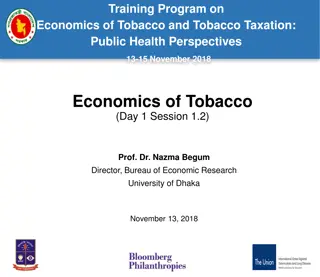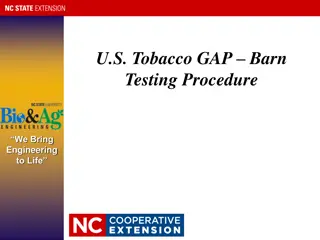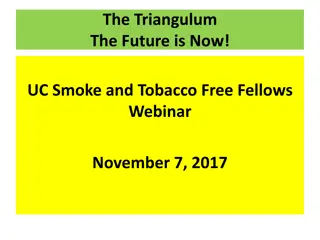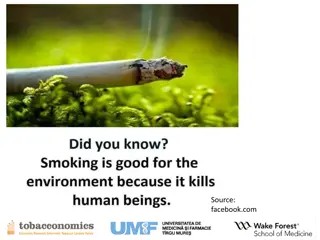Tobacco Use among Rural Secondary Students: A Global Perspective
The prevalence of tobacco use is increasing in developing countries, with a significant impact on morbidity and mortality. Initiatives like the Global Survey of Youth Tobacco highlight the need for awareness and education. The WHO's Framework on Tobacco Control underscores the importance of protective measures. Addressing this issue is crucial to combating smoking-related diseases and promoting healthy lifestyles.
Download Presentation

Please find below an Image/Link to download the presentation.
The content on the website is provided AS IS for your information and personal use only. It may not be sold, licensed, or shared on other websites without obtaining consent from the author. Download presentation by click this link. If you encounter any issues during the download, it is possible that the publisher has removed the file from their server.
E N D
Presentation Transcript
Use of tobbaco in rural secondary students Ortega-Ceballos PA, M en C; Terrazas-Meraz MA, Dr; Arizmendi-Jaime ER, Dr; Tapia-Dom nguez M, MSC,
Introduction The World Health Organization (WHO) reported that overall, the prevalence of use of tobacco is declining in many developed countries, but increasing in developing countries, in addition to about 1.3 billion people worldwide smoke1and 47.5% of men smoke compared to 10.3% of women.2 1.-World Health Organization: The WHO Reports on the Global Tobacco Epidemic. Geneva: WHO; 2008. 2.-World Health Organization: The world health report 2002.reducing risks, promoting healthy life. Geneva: WHO; 2002
In the book review for Cigarette Century, Hall said that "Since the publication of the Report of the Surgeon General on Smoking and Health in 1964, the health workers around the world have highlighted smoking as a risk to major health ".3 3.-Hall W: (Book Review) cigarette century: the rise, fall and deadly persistence of the product that defined America. Tob Control 2007, 16:360.
Smoking morbidity and mortality in developed countries, is related deaths due to obstructive pulmonary disease and brainvascular disease. is the leading preventable cause of lung cancer, ischemic chronic heart disease,
The Global Survey of Youth Tobacco (GYTS) reported that about 25% of all adolescents who experiment with cigarette smoking become regular smokers, and among smokers, about a third die from a disease related to use of tobacco; It stresses that only half of the participants reported they had been taught in school about the dangers of smoking during the year preceding the survey.4 4.-Global Youth Tobacco Survey Collaborative Group. Tobacco use among youth: a cross country comparison. Tob Control 2002; 11:252-70.
CMCT In 2003, the World Health Organization (WHO) adopted the Framework on Tobacco Control (FCTC)* Convention *Organizaci n Mundial de la Salud. Convenio Marco de la OMS para el Control del Tabaco. Ginebra, 2004. Disponible en: http://www.paho.org/Spanish/DD/PUB/sa56r1.pdf
Article 8 encourages each party to adopt and implement effective administrative for protection against exposure to smoking in public places measures. legislative, executive,
The study of smoking in students who are undergoing training is important, taking into account future risks of chronic diseases.
Objective Determine factors associated with use of tobacco in adolescents in secondary level of northern Morelos.
Material y methods Study Design: This is a cross-sectional epidemiological study. The project is part of the research "Promotion and self-care" Our Academic team: "Nursing: education, care and health" is in the School of Nursing at the Universidad Aut noma del Estado de Morelos.
Material y methods Universe study Students were invited to participate assigned to a North Morelos State secondary school .
Material y methods Sampling The sampling method used is not probabilistic for convenience. The sample was composed of 269 students who answered a self-administered November 2014. questionnaire in
Selection criteria: Students enrolled during the 2014-2015 period. Students who want to participate Exclusion criteria: Students not assigned to the secondary level. Elimination criteria: Participants with less than 80% of the questionnaire responses.
Material y methods Instrument Sociodemographic characteristics (age, sex, degree), use of tobacco, attitudes and knowledge about smoking were detailed.
Statistical analysis Measures of central tendency and frequencies were obtained. The measure of association used was the prevalence , odds ratio with confidence intervals of 95% (95% CI OR).
Statistical analysis The statistical analysis was performed with the statistical package STATA 14.0.
Sociodemographic characteristics. Secondary level students, Mexico, 2014. . tab sexo sexo | Freq. Percent Cum. ------------+----------------------------------- Hombre | 144 53.53 53.53 Mujer | 125 46.47 100.00 ------------+----------------------------------- Total | 269 100.00 . sum edad,d edad ------------------------------------------------------------- Percentiles Smallest 1% 11 11 5% 12 11 10% 12 11 Obs 250 25% 12 11 Sum of Wgt. 250 50% 13 Mean 13.068 Largest Std. Dev. 1.005695 75% 14 15 90% 14 15 Variance 1.011422 95% 15 15 Skewness .2909558 99% 15 16 Kurtosis 2.309813
Experimenters and current smokers. Secondary level students, Mexico, 2014. . tab probar probar | Freq. Percent Cum. ------------+----------------------------------- No | 176 66.67 66.67 S | 88 33.33 100.00 ------------+----------------------------------- Total | 264 100.00 . tab fumador fumador | Freq. Percent ------------+----------------------------------- No fumador | 202 83.47 83.47 Fumador | 40 16.53 100.00 ------------+----------------------------------- Total | 242 100.00 Cum.
Susceptible population. Secondary level students, Mexico, 2014. . tab var68 sexo2,col | sexo2 var68 | 1=Hombre 2=Mujer | Total -----------+----------------------+---------- S | 23 16 | 39 | 15.97 13.01 | 14.61 -----------+----------------------+---------- No | 121 107 | 228 | 84.03 86.99 | 85.39 -----------+----------------------+---------- Total | 144 123 | 267 | 100.00 100.00 | 100.00 They smoke if your best friend offered him a cigar . tab var69 sexo2,col | sexo2 var69 | 1=Hombre 2=Mujer | Total -----------+----------------------+---------- S | 24 25 | 49 | 16.67 20.66 | 18.49 -----------+----------------------+---------- No | 120 96 | 216 | 83.33 79.34 | 81.51 -----------+----------------------+---------- Total | 144 121 | 265 | 100.00 100.00 | 100.00 They believe that in the next 12 months cigar smoking
Susceptible population. Secondary level students, Mexico, 2014. gen susceptible=. replace susceptible=1 if var68==1 & var69==1 replace susceptible=0 if var68==2 & var69==2 replace susceptible=0 if var68==2 | var69==2 graph bar (count), over (sexo) over (susceptible) bargap(-30) legend( label(1 "Mujer") label(2 "Hombre") ) title("Figure I. Susceptibility to use of tobacco by sex..") subtitle(" Secondary level students. Morelos, Mexico, 2014-2015.")note("Source: Survey on self-care in adolescents.") blabel(bar, position(inside) format(%9.1f) color(white))
Figure I. Susceptibility to use of tobacco by sex. Secondary level students. Morelos, Mexico, 2014-2015. 150 133 111 100 Frecuency 50 12 11 0 Boys Girls Boys Girls 0 1 Source: Survey on self-care in adolescents.
Prevalence of smoking by gender and grade. Secondary level students, Mexico, 2014. . sort fumador . by fumador:tab sexo grado ---------------------------------------------------------------------------- -> fumador = 0 | grado sexo | 1 2 3 | Total -----------+---------------------------------+---------- 1=Hombre | 41 38 31 | 110 2=Mujer | 35 36 21 | 92 -----------+---------------------------------+---------- Total | 76 74 52 | 202 ---------------------------------------------------------------------------- -> fumador = 1 | grado sexo | 1 2 3 | Total -----------+---------------------------------+---------- 1=Hombre | 5 8 10 | 23 2=Mujer | 5 7 5 | 17 -----------+---------------------------------+---------- Total | 10 15 15 | 40
graph bar (count), over (p1) over (fumador) over( grado) bargap(-30) legend( label(1 Girls") label(2 Boys") ) title(" Figure II. Smoking prevalence by sex and grade.") subtitle(" Secondary level students. Morelos, Mexico, 2014-2015.") note(" Source: Survey on self-care in adolescents.") blabel(bar, position(inside) format(%9.1f) color(black)) bar(1, fcolor(Light khaki)) bar(2, fcolor(navy))
Figure II. Smoking prevalence by sex and grade. Secondary level students. Morelos, Mexico, 2014-2015. 41 40 38 36 35 31 30 frequency 21 20 10 10 8 7 5 5 5 0 Non smokers Smokers Non smokers Smokers Non smokers Smokers 1 2 3 Girls Boys Source: Survey on self-care in adolescents.
fumador coefEform VARIABLES ci_lowEform ci_highEform fumador sexo2 _Iofrecer_1 _Ifumar_fut_1 _Iamigos_1 OH _Iexp_lp_2 Constant 0.987 5.166*** 2.412* 2.805* 2.511** 2.442** 0.0359*** 0.425 1.98 0.927 0.939 1.014 1.023 0.00804 2.292 13.48 6.278 8.376 6.223 5.829 0.16 Observations seEform in parentheses *** p<0.01, ** p<0.05, * p<0.1 236 *Estad sticamente significativo
Table1. Factors associated with use of tobacco. Secondary level students. Morelos, Mexico, 2014-2015. VARIABLES OR IC 95% Sex 0.987 0.425 2.292 Would smoke if a friend offered him a cigar 5.166*** 1.98 13.48 They believe smoking in the next 12 months 2.412* 0.927 6.278 Some of his best friends smoke 2.805* 0.939 8.376 Alcohol consume 2.511** 1.014 6.223 Tobbaco smoke exposure in public places 2.442** 1.023 5.829
Conclusions Associated factors were marginally students, who are smoking in the future and those with smoking friends. The significantly associated aceptance if they were offered, those who consume alcohol and the smoke expossure in public places factors were the smoking
Conclusions The statistical package STATA is a statistical tool that facilitates the organization, preparation research. and presentation of the It allows easily spread the results of research conducted in the area of health. It is based on the foundation of inference and serves to identify which students focused interventions needed to promote quit and prevent initiation of consumption of tobacco.
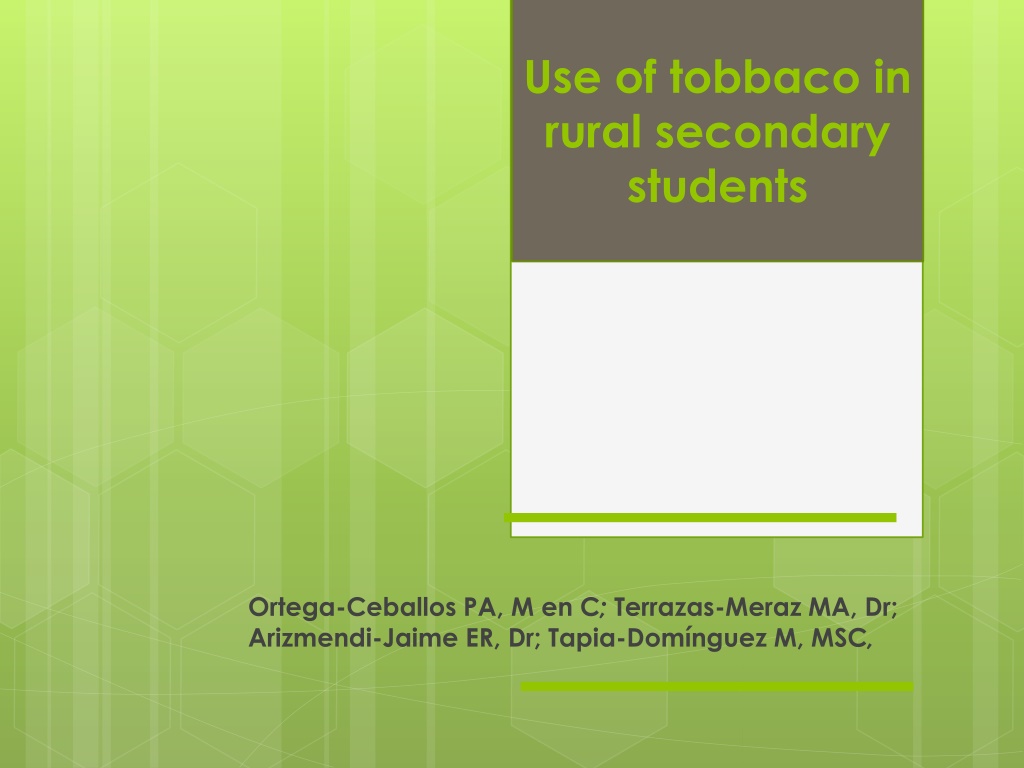

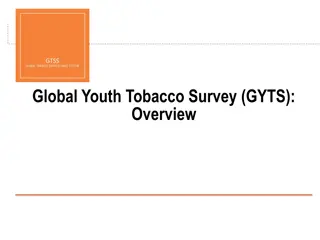


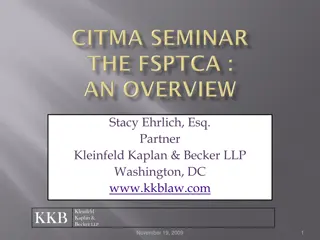
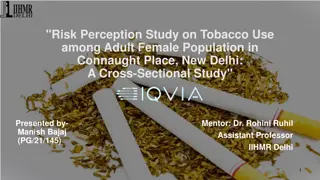
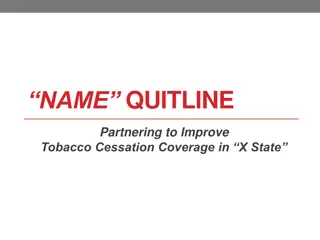
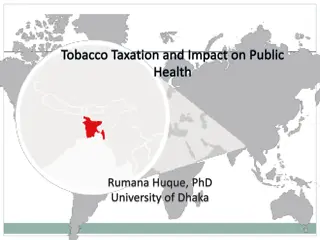
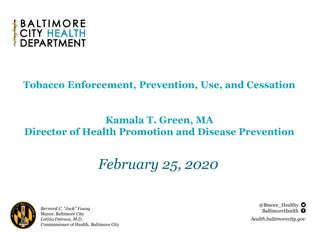
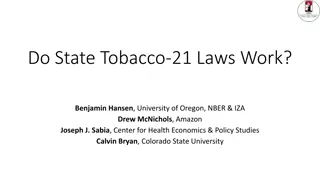
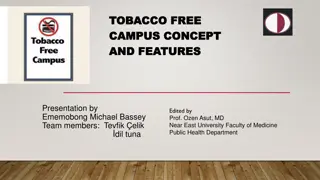
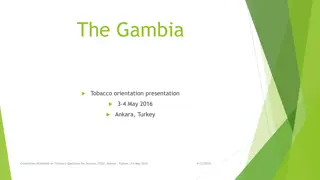
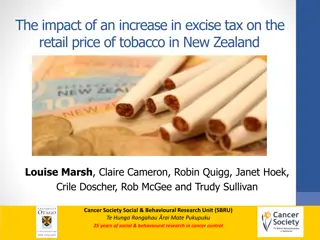
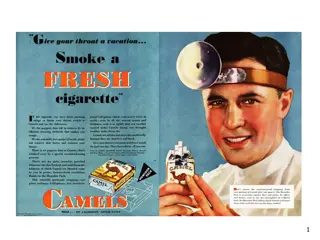
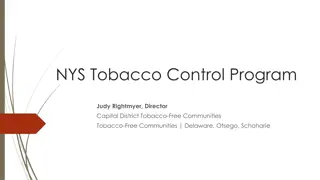
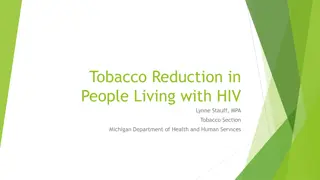
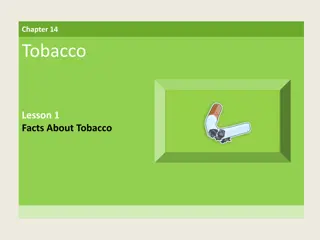
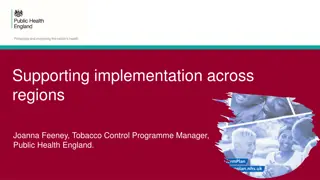

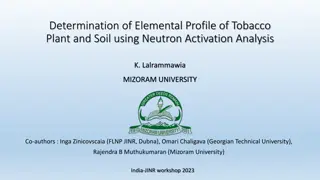


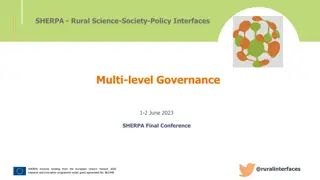
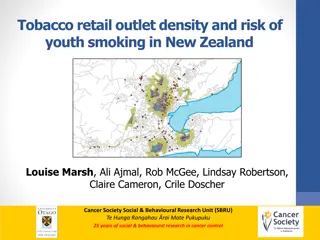


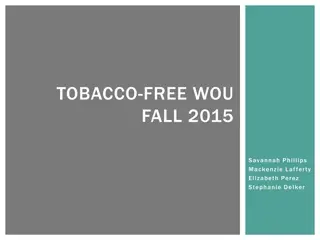
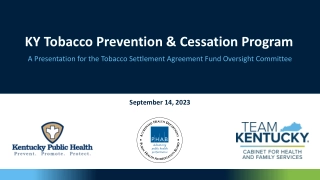
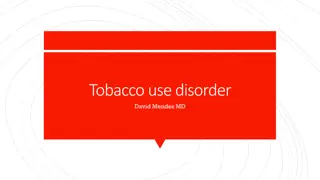
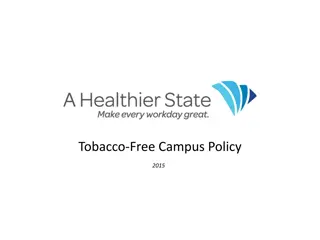
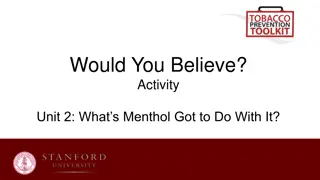
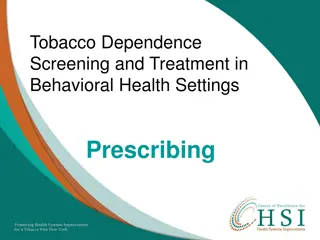
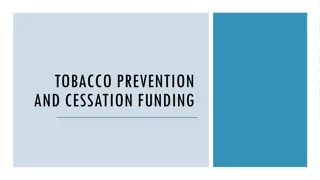



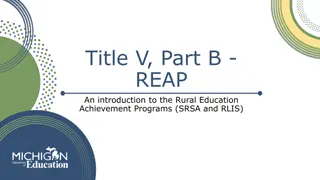

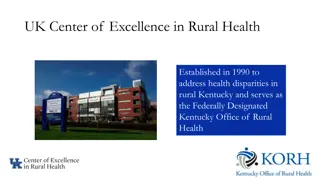
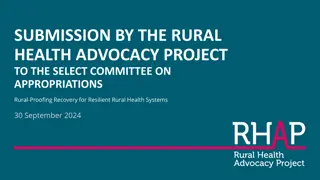
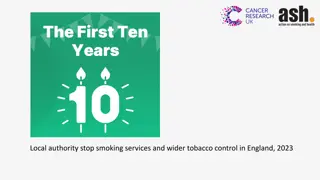
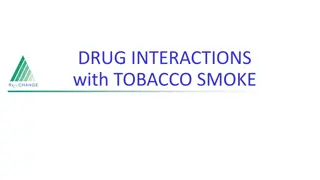
![Protecting Youth Through Tobacco Retail Licensing in [Your County]](/thumb/175307/protecting-youth-through-tobacco-retail-licensing-in-your-county.jpg)
